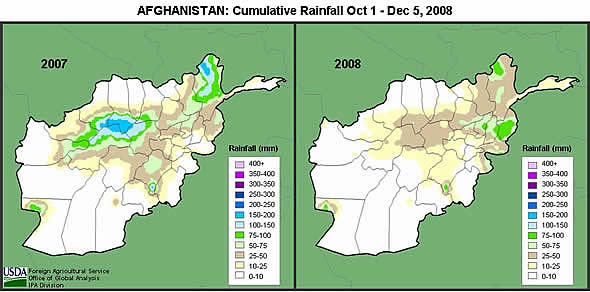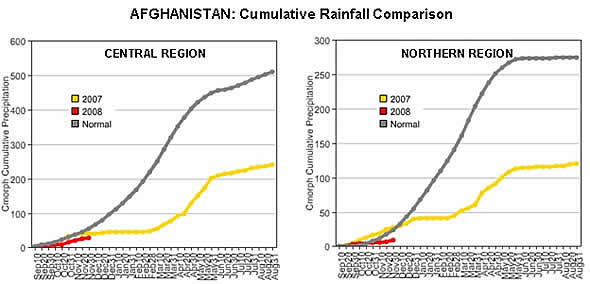AFGHANISTAN: 2009/10 Wheat Production Outlook Uncertain
 Afghanistan suffered a severe drought last year which decimated its 2008/09 winter grain crop and caused an acute food and feed-grain shortage throughout much of the country. Wheat production is estimated by USDA to have fallen 55 percent from the previous year, while barley production is estimated to have declined 67 percent. This major shortfall in grain production was exacerbated by disruptions in regional grain trade (export bans) and increasing conflict in major transport corridors along the Pakistani border. Afghanistan suffered a severe drought last year which decimated its 2008/09 winter grain crop and caused an acute food and feed-grain shortage throughout much of the country. Wheat production is estimated by USDA to have fallen 55 percent from the previous year, while barley production is estimated to have declined 67 percent. This major shortfall in grain production was exacerbated by disruptions in regional grain trade (export bans) and increasing conflict in major transport corridors along the Pakistani border.
The seriously diminished supply of wheat in the country caused local market prices to increase dramatically this year, with retail wheat prices averaging 200 percent above their normal levels in most markets. The government of Afghanistan and the United Nations issued a $400 million emergency food appeal in July in hopes of acquiring sufficient grain imports, certified seed, and fertilizers prior to the onset of winter, when many regions become isolated. They have estimated that 4.5 million people will require food aid for the bulk of the winter months and that the shortfall in food grain supply is critical in the worst affected drought regions.
However, five months after the appeal was issued there has yet to be a significant decline in regional grain prices. This indicates that the basic supply of wheat, the country’s primary food grain, is still largely insufficient to meet ordinary demand. As of December 2, the government and food aid agencies have also only been able to distribute 31 percent of a planned 163,000 tons of emergency winter grain stocks to the affected provinces. As such, the prospects for the upcoming 2009/10 wheat crop are becoming more important insofar as assessing the scope of food insecurity in the country and its immediate grain import needs.

As the new 2009/10 winter grain planting season came to a close at the end of November, farmers, government officials, and food aid agencies are hoping for a substantial recovery in national grain production to forestall an even more serious humanitarian situation in 2009. As of early December 2008, however, it is evident that rainfall conditions have been less favorable than even last year and that the initial outlook for wheat production at this early stage is questionable.

Autumn precipitation during the primary winter wheat planting period from October through November was well below normal and in some cases worse than last year. The central region of Afghanistan, the primary central highlands of the Hindu Kush Mountains, is where critical snowpack accumulations during the winter help determine the extent and scale of irrigation supplies for the coming grain production season. The low rainfall pattern to-date in this region is a cause for concern. However, the greatest amount of precipitation in this region typically occurs in the December-April period, so there is plenty of time to make up for current shortfalls. Close monitoring of the winter snowpack is warranted under the circumstances to assure that adequate irrigation supplies will be available in the spring. Last year a lighter than normal snowpack was quickly melted by above normal spring temperatures, leading to an acute shortage of irrigation supplies for both winter and summer crop production. This year Afghanistan requires a normal or above normal snowpack and mild spring temperatures to ensure an adequate recovery of irrigated grain production.
 Rainfall during the autumn planting period in the important northern production region was also extremely low. This region was severely impacted by drought last year with widespread reports of crop failure in both rainfed and irrigated grains. The northern region is the nation’s leading grain producer, normally accounting for roughly 30 percent of the total national wheat output. As with the central region, the bulk of annual rainfall occurs from December to April, so there is ample opportunity for improvement in coming months. However, this region has a huge amount of land devoted to rainfed grain production, the majority of which is believed to be planted in the autumn. Any rainfed grains sown since October would have occurred in predominantly dry soils, with no stored soil moisture to draw on for germination and early emergence. Given the severity of the drought in 2008 it is also unknown whether seed and irrigation supplies in the northern region were adequate to allow farmers to sow a normal aount of irrigated winter wheat this year. Rainfall during the autumn planting period in the important northern production region was also extremely low. This region was severely impacted by drought last year with widespread reports of crop failure in both rainfed and irrigated grains. The northern region is the nation’s leading grain producer, normally accounting for roughly 30 percent of the total national wheat output. As with the central region, the bulk of annual rainfall occurs from December to April, so there is ample opportunity for improvement in coming months. However, this region has a huge amount of land devoted to rainfed grain production, the majority of which is believed to be planted in the autumn. Any rainfed grains sown since October would have occurred in predominantly dry soils, with no stored soil moisture to draw on for germination and early emergence. Given the severity of the drought in 2008 it is also unknown whether seed and irrigation supplies in the northern region were adequate to allow farmers to sow a normal aount of irrigated winter wheat this year.

Autumn rainfall accumulations were also extremely poor in the other major producing regions of the northeast and west. When combined with the northern region, these 3 regions normally account for roughly 70 percent of total national wheat production. If there is to be a near-normal or above-normal wheat crop in Afghanistan this year, these three northern regions must see a sizable increase in winter precipitation, as well as near-normal spring rains in March, April, and May. The production potential for both the irrigated and rainfed wheat crop will depend on this.

According to Afghan government statistics there is at least 1.25 million hectares of non-irrigated wheat land in these 3 major northern wheat producing regions, accounting for roughly 52 percent of total national wheat area. There is a lot at stake insofar as grain production potential in 2009/10 resting on the fate of these rainfed crop lands. Given the severity of drought conditions in 2008/09, it is believed that much of the rainfed croplands in the three primary northern producing regions had extremely limited amounts of harvestable grain. Widespread incidences of crop failure were reported throughout these major producing provinces. Whatever grain was harvested on these lands would have questionable value for seed in the new growing season, given the effect of extreme moisture stress on its germination and yield potential.

Conclusions:
Given the extremely high prices for wheat in most regional markets this year, there was adequate incentive for growers to increase national wheat acreage this year. However, as the 2009/10 winter grain planting period closed in early December the outlook for Afghanistan’s next wheat harvest is uncertain. Rainfall has been well below normal, and below last year’s levels in important regions. It is unknown whether there was adequate wheat seed and irrigation supplies throughout the country at planting time. This is especially true in the three major producing regions in the north, where the majority of national wheat acreage and production occur. These important regions experienced severe rainfed and irrigated crop losses last year. Because of these factors, it is as yet unknown whether sown wheat area in Afghanistan will recover to normal levels this year, irrespective of how favorable or unfavorable the rainfall regime will be in forthcoming months.
Current USDA area and production estimates for grains and other agricultural commodities are available on IPAD's Agricultural Production page or at PSD Online.
|

